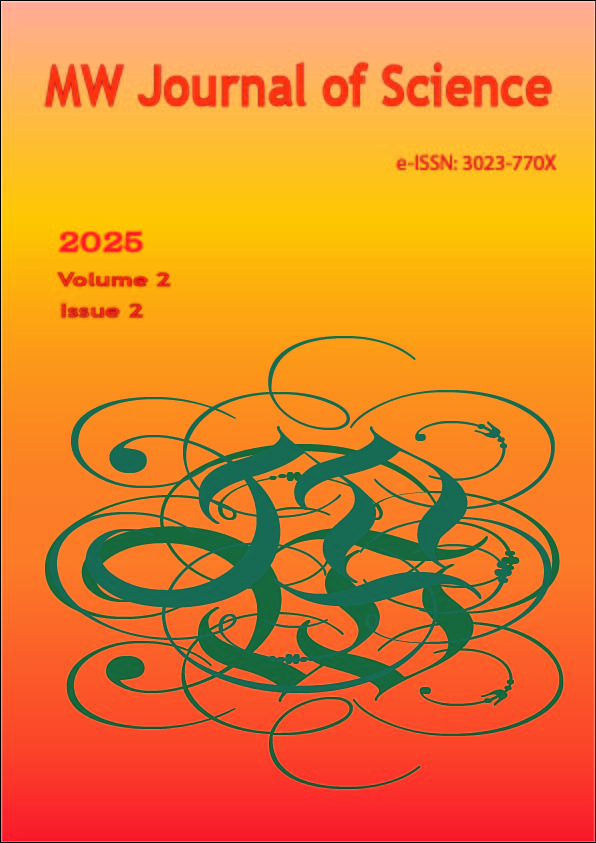Antibacterial and Microstructural Evolution in Silver Modified NiTi Shape Memory Alloy
DOI:
https://doi.org/10.5281/zenodo.16745547Keywords:
NiTiAg alloy, antibacterial, shape memory alloys, antibacterial, shape memory alloysAbstract
This study examines the microstructural properties, phase behavior, and antibacterial activity of nickel-titanium (NiTi) shape memory alloys (SMAs) doped with varying concentrations of silver (Ag). Five distinct alloys were produced through arc melting followed by homogenization. X-ray diffraction (XRD) analysis revealed that increasing Ag content stabilizes the B2 phase and suppresses martensitic transformation. Microstructural evaluations showed that low Ag content promoted grain refinement, whereas higher additions led to the formation of secondary phases. Disk diffusion tests indicated a notable antibacterial effect in the Ag4 sample, particularly against Escherichia coli (E. coli) and Staphylococcus aureus (S. aureus). The results suggest that Ag doping enhances the antimicrobial efficacy of NiTi alloys, making them promising candidates for reducing infection risks in biomedical applications.
References
Bhardwaj, A., et al., Characterization of mechanical and microstructural properties of constrained groove pressed nitinol shape memory alloy for biomedical applications. Materials Science and Engineering: C, 2019. 102: p. 730-742.
Chaudhary, K., V.K. Haribhakta, and P.V. Jadhav, A review of shape memory alloys in MEMS devices and biomedical applications. Materials Today: Proceedings, 2024.
Shukla, U. and K. Garg, Journey of smart material from composite to shape memory alloy (SMA), characterization and their applications-A review. Smart Materials in Medicine, 2023. 4: p. 227-242.
Es-Souni, M., M. Es-Souni, and H. Fischer-Brandies, Assessing the biocompatibility of NiTi shape memory alloys used for medical applications. Analytical and bioanalytical chemistry, 2005. 381: p. 557-567.
Jiao, Z., et al., Phase transition, twinning, and spall damage of NiTi shape memory alloys under shock loading. Materials Science and Engineering: A, 2023. 869: p. 144775.
Han, X., S. Mao, and Z. Zhang, Superelasticity and the Shape Memory Effect, in Encyclopedia of Nanotechnology, B. Bhushan, Editor. 2016, Springer Netherlands: Dordrecht. p. 3874-3880.
Nargatti, K. and S. Ahankari, Advances in enhancing structural and functional fatigue resistance of superelastic NiTi shape memory alloy: A Review. Journal of Intelligent Material Systems and Structures, 2022. 33(4): p. 503-531.
Patel, S.K., et al., A review on NiTi alloys for biomedical applications and their biocompatibility. Materials today: proceedings, 2020. 33: p. 5548-5551.
Liu, Y., et al., Some aspects of the properties of NiTi shape memory alloy. Journal of alloys and compounds, 1997. 247(1-2): p. 115-121.
Keun-Taek Oh 1, U.-H.J., Gee-Ho Park, Chung-Ju Hwang, Kyoung-Nam Kim, Effect of silver addition on the properties of nickel-titanium alloys for dental application. Journal of biomedical materials research Part B, 2006. 76(2): p. 306–314.
Lansdown, A., Silver in health care: antimicrobial effects and safety in use. CURRENT PROBLEMS IN DERMATOLOGY-BASEL-, 2006. 33(R): p. 17.
Rai, M., A. Yadav, and A. Gade, Silver nanoparticles as a new generation of antimicrobials. Biotechnology advances, 2009. 27(1): p. 76-83.
Zhang, E., et al., Antibacterial metals and alloys for potential biomedical implants. Bioactive materials, 2021. 6(8): p. 2569-2612.
Jiao, J., et al., Recent advances in research on antibacterial metals and alloys as implant materials. Frontiers in cellular and infection microbiology, 2021. 11: p. 693939.
Salman, K.D., et al., Microstructural Analysis and Mechanical Characterization of Shape Memory Alloy Ni-Ti-Ag Synthesized by Casting Route. Applied Sciences, 2022. 12(9): p. 4639.
Baigonakova, G., et al., Influence of silver addition on structure, martensite transformations and mechanical properties of TiNi–Ag alloy wires for biomedical application. Materials, 2020. 13(21): p. 4721.
Qader, I.N., E. Ercan, and A. Orhan, Effect of boron element additions on microstructure, biocompatibility, and thermodynamic parameters of NiTi shape memory alloy. JOM, 2022. 74(11): p. 4402-4409.
Gao, J., et al., Well-Adhered Ti Alloying Layer on NiTi Alloy: Surface Ni Content, Corrosion Resistance, and Cytocompatibility. Journal of Materials Engineering and Performance, 2024: p. 1-11.
Kök, M. and G. Ateş, The effect of addition of various elements on properties of NiTi-based shape memory alloys for biomedical application. The European Physical Journal Plus, 2017. 132(4): p. 185.
Kök, M., et al., The effects of cobalt elements addition on Ti2Ni phases, thermodynamics parameters, crystal structure and transformation temperature of NiTi shape memory alloys. The European Physical Journal Plus, 2019. 134(5): p. 197.
Kök, M., et al., Thermal stability and some thermodynamics analysis of heat treated quaternary CuAlNiTa shape memory alloy. Materials Research Express, 2019. 7(1): p. 015702.
Waitz, T., et al., Size-dependent martensitic transformation path causing atomic-scale twinning of nanocrystalline NiTi shape memory alloys. Europhysics Letters, 2005. 71(1): p. 98.
Zhang, H., et al., Influence of Ag on microstructure, mechanical properties and tribological properties of as-cast Al-33Zn-2Cu high-zinc aluminum alloy. Journal of Alloys and Compounds, 2022. 922: p. 166157.
Downloads
Published
How to Cite
Issue
Section
License
Copyright (c) 2025 MW Journal of Science

This work is licensed under a Creative Commons Attribution 4.0 International License.


